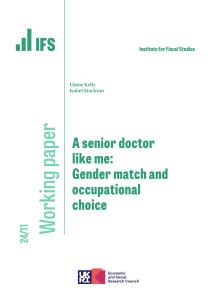The NHS waiting list in England stands at 7.6 million, almost 400,000 higher than it was in January 2023 when the Prime Minister promised to get waiting lists falling and 3 million higher than pre-pandemic levels. Yet recent months have shown signs of hope. The waiting list fell for three consecutive months at the end of 2023 (from 7.8 million in September to 7.6 million in December). This partly reflected seasonal factors (the waiting list tends to fall at that time of year), but also genuine increases in NHS treatment volumes.
By the general election, NHS waiting lists in England are likely to be steadily falling. That would be a very welcome development. But getting waiting lists and – perhaps more importantly – waiting times back down to pre-pandemic levels will take years and, more likely than not, more than a full parliamentary term.
These are among the findings of a new pre-election IFS briefing, funded by the abrdn Financial Fairness Trust and the Nuffield Foundation, which examines past NHS performance and the likely future path of NHS waiting lists. IFS researchers have also updated their prize-winning interactive tool, which allows users to generate their own scenarios for NHS waiting lists.
Other key findings of the briefing include:
- A focus on the national figures hides considerable variation in how much waiting lists have grown in different areas and in different medical specialties. In all local NHS commissioning areas, the elective waiting list in December 2023 was higher than pre-pandemic, but the increase ranged from around 1.3 times higher (in Calderdale, West Yorkshire) to almost 2.5 times higher (in St Helens, Cheshire & Merseyside). Over the same period, the waiting list for general internal medicine fell by 2% while the waiting list for gynaecology more than doubled.
- The NHS looks near-certain to miss its February 2022 target to increase pre-planned hospital activity to 21% above pre-pandemic levels by 2024–25. Nonetheless, under our central set of assumptions, we expect the NHS waiting list to start falling consistently by the summer of 2024 and to reach 7.4 million by December 2024 and 6.5 million by December 2027 (down from 7.6 million today, and up from 4.6 million pre-pandemic and 2.3 million in January 2010).
- Other NHS waiting lists and waiting times (for things other than pre-planned care) in England were also rising pre-pandemic and have risen even faster since 2020. In September 2023, one-in-four cancer patients waited longer than two weeks from a GP urgent referral to their first consultant appointment, for example, compared with fewer than one-in-ten in December 2019 and fewer than one-in-twenty in December 2009.
Max Warner, a Research Economist at IFS and an author of the report, said:
‘The next government may well inherit a falling elective NHS waiting list in England. But even with a trend pointing in the right direction, waiting lists will still be far higher than they have been – and long waiting times are unlikely to go away any time soon. Even under an optimistic set of assumptions, we estimate that in four years’ time the waiting list will still be higher than at the start of the pandemic, which itself was much higher than the waiting list in the early 2010s.
‘If bringing down waiting lists quickly is a priority, then the next government will likely need both to dedicate additional funding to the health service and to find ways to increase NHS productivity. These are not easy fixes: big increases in NHS funding without accompanying tax rises could require some eye-wateringly tough choices elsewhere, and solving the NHS productivity puzzle could require up-front investment and years of unrelenting policy focus.’
Mark Franks, Director of Welfare at the Nuffield Foundation, said:
‘We have witnessed over a decade of increasing NHS waiting lists, influenced by factors such as a growing and ageing population. More recently, the pandemic has exacerbated this issue by hindering the NHS’s capacity to provide healthcare services. If our public health services are to recover, the next government needs a credible and sustainable plan for tackling the NHS’s capacity, funding and productivity issues. It must also be transparent about the magnitude of the challenge, the necessary trade-offs and the reality that, even under the most optimistic projections, it will take many years for waiting lists to revert to the levels seen at the beginning of the last decade.'










